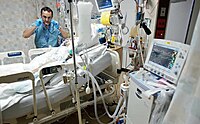
Photo from wikipedia
Introduction/Hypothesis: The number of women in workforce has significantly increased in last few years; however, gender disparity in academic medicine is still a topic of great discussion. In recent years… Click to show full abstract
Introduction/Hypothesis: The number of women in workforce has significantly increased in last few years; however, gender disparity in academic medicine is still a topic of great discussion. In recent years there has been extensive interest in promoting gender equality within pulmonary/critical care medicine, a predominately male field. In this study, our aim was to assess gender differences in faculty rankings of adult pulmonary/critical care and determine any related factors that may contribute to any such disparity. Methods: We obtained a list of clinical faculty at 157 pulmonary/ critical care fellowship programs using American Medical Association’s (AMA) Fellowship and Residency Electronic Interactive Database (FREIDA) and program websites (June 2019). We further collected data on faculty including gender, academic rank, total years of active research, and H-indices by searching program’s website as well as Doximity and Scopus databases. Results: We included 3336 faculty members who met our inclusion criteria in the final analysis of whom 30.5% were women. Compared to men, the proportion of women was surprisingly lower at senior faculty ranks such as full professor (13.18% versus 30.49%) and associate professor (23.60% versus 26.13%). However, a higher proportion of female faculty was found at the level of assistant professor (56.24% versus 39.80%) and clinical instructor (6.49% versus 3.58%). Female faculty on average had a significantly lower mean H-index (8.41 versus 15.19; p<0.05) but they also had fewer years of active research years (11.96 versus 17.92; p<0.05). Furthermore, the H-index difference between men and women was more at higher ranks than at lower ranks. Conclusions: Our study shows that gender disparity exists at senior faculty ranks of academic pulmonary/critical care faculty. Women face barriers in advancement to the rank of associate and full professor despite having almost equal academic productivity at the lower faculty ranks, compared to men. Further studies are needed to explore and adequately address the barriers to academic advancement of women faculty in pulmonary/critical care medicine.
Journal Title: Critical Care Medicine
Year Published: 2020
Link to full text (if available)
Share on Social Media: Sign Up to like & get
recommendations!